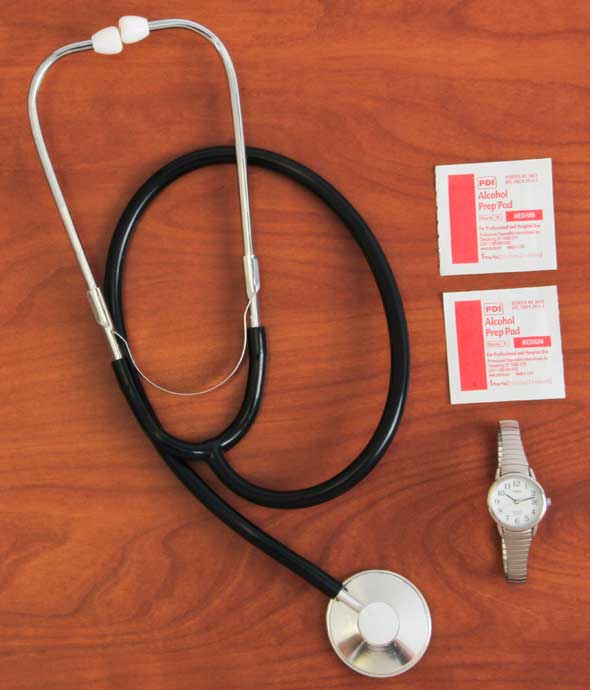Vital Signs
Select a Skill:
- » Taking a Temperature
- » Assessing Radial Pulse
- » Assessing Apical Pulse
- » Assessing Apical-Radial Pulse
- » Assessing Respiration: Rate, Rhythm, and Effort
- » Obtaining Blood Pressure by the One-Step Method
- » Obtaining Blood Pressure by the Two-Step Method
- » Measuring Oxygen Saturation with Pulse Oximetry
- » Assessing Pain
- » Measuring Height and Weight
Take the Review Test:

Safety
- Use Standard Precautions when assessing an apical-radial pulse.
- Assess the apical-radial pulse for a full 60 seconds.
- If you detect a pulse deficit, immediately assess for other signs and symptoms of decreased cardiac output.
- Clean the earpieces and diaphragm of the stethoscope with alcohol after each use.
- Assess the patient for latex allergy. If the patient has a latex allergy, ensure that the stethoscope is latex free.
- Report the presence of a pulse deficit, irregular pulses, irregular rhythms, or weak strength, or pulse rates of less than 60 or more than 100 beats per minute to the health care provider without delay. Immediate intervention may be needed.
Equipment
(Roll cursor over items to see labels)

Stethoscope
Watch with second hand or digital display
Alcohol swab
Delegation
The skill of assessing apical-radial pulse deficit cannot be delegated to nursing assistive personnel (NAP). Collaboration between the nurse and a second health care provider is required.
Preparation
- Assess for factors that suggest a possible pulse deficit: an irregular heart rate and signs and symptoms of decreased cardiac output, such as dyspnea, fatigue, chest pain, orthopnea, dizziness or syncope, palpitations, edema of dependent body parts, and cyanosis or pallor of the skin.
- Obtain the help of a second health care provider.
Follow-up
- If a pulse deficit is noted, assess for signs and symptoms of decreased cardiac output, such as dyspnea, fatigue, chest pain, orthopnea, syncope, palpitations, edema of dependent body parts, and cyanosis or pallor of the skin.
- Discuss your findings with the patient as needed.
- Report the presence of a pulse deficit and any related signs and symptoms to the nurse in charge or to the health care provider.
Documentation
- Record the apical pulse, the radial pulse and site, and the pulse deficit.
- Inform the nurse in charge or the health care provider of the presence of a pulse deficit.
Review Questions
1. What is the major health problem resulting from a pulse deficit?
2. What should the nurse do when a pulse deficit is suspected?
 Measure the radial pulse for 1 minute, and then measure the apical pulse for 1 minute.
Measure the radial pulse for 1 minute, and then measure the apical pulse for 1 minute. Measure the radial pulse for 30 seconds, and then measure the apical pulse for 30 seconds.
Measure the radial pulse for 30 seconds, and then measure the apical pulse for 30 seconds.  Measure the radial pulse for 1 minute, wait 5 minutes, and then measure the apical pulse for 1 minute.
Measure the radial pulse for 1 minute, wait 5 minutes, and then measure the apical pulse for 1 minute.  Ask another health care provider to count the radial pulse while the nurse counts the apical pulse.
Ask another health care provider to count the radial pulse while the nurse counts the apical pulse.
3. Which action should the nurse perform after identifying a pulse deficit?
 Reassess the apical-radial pulse in 5 minutes.
Reassess the apical-radial pulse in 5 minutes. Assess the patient for signs of decreased cardiac output.
Assess the patient for signs of decreased cardiac output. Notify the primary health care provider of the pulse deficit.
Notify the primary health care provider of the pulse deficit. Initiate interventions directed toward managing the patient’s symptoms.
Initiate interventions directed toward managing the patient’s symptoms.
4. You have the following information:
Oral temperature—36.8° C;
Radial Pulse—112 weak, thready;
Apical pulse—117 regular;
Respirations—24 regular;
Blood Pressure—104/56 right arm;
Blood Pressure—102/50 left arm.
What is the pulse deficit?
5. Which of the following is an early manifestation of decreased cardiac output?
You have completed the Review Questions for this skill. To take the Review again select the Start Over button. To proceed to another skill select from the dropdown menu. Select the Home or Back button to proceed to the next section.


